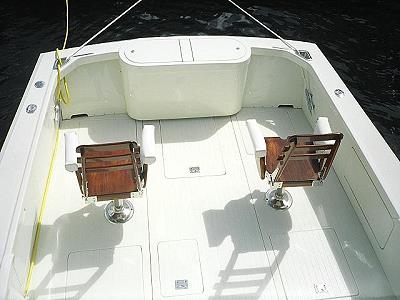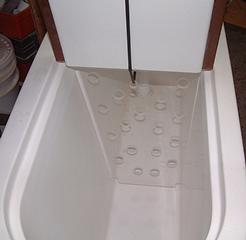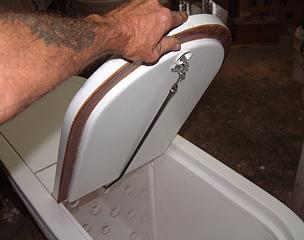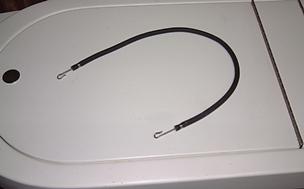Custom Livewell for the Bertram 31
©
The first composite image is a map that will link to a specific larger image in a new browser window. Just click the window off when through viewing...

Please Read Carefully before ordering any parts.
The production cost of the finished unit, ready to be installed, is $4,300.00 FOB, LLANO, TX. Domestic shipments will be by motor freight.
I know this sounds a bit pricy for a livewell, but then it's far superior to any other livewell on the market, it's designed especially for the B31, is totally custom built and is easy enough to permanently install that even a relative novice can do the job.
Once you've read this whole page, I think you'll agree that value and quality support the price...
The full insulation rates it at near R10, and it takes almost 100 hours to produce. My intent from the beginning was to create a truly unique and high end livewell that will, most probably, be a limited edition of no more than 10 units. The first similar well was installed as a "one off" design on Jerry Wells' "Fortuna", (now the "Ishgair" owned by Kevin Schuller). Numerous design features and refinements have been engineered since then and the production tooling has evolved over a period of 4 years and several hundred hours with an estimated tooling cost of around $3,500.00.
Unique features include:
Multi-port water jacket delivery of fill water:The volume of the interior of the livewell is 4.4 cu ft, with a useable water fill of 35 gallons. Since the well if fully insulated at a minimum of 1 1/2" of 2 lb per cu ft polyurethane foam, (2 part pourable used, not the cheap one part pressure can stuff), the well is very usable as a fish box or one hellofa' ice chest.Why a Multi-port, water jacket fill system? A single source hole introduces the water at in much heavier stream which can both damage delicate live baits, (such as sardines), and if directed at a 90 degree angle to develop a rotational current flow, the fitting is now protruding into the well. By contrast, the multi-port, water jacket fill system is recessed into the wall of the well and because the water delivery is spread between multiple holes, the input is a far more gentle stream. It also contacts the side of the well quicker and flatter, further reducing any turbulence. In any livewell, there should be no hard angle corners for the bait to get trapped into, and a gentle currant is necessary to allow the baits to swim in a more orientated pattern.
Fully insulated with 2 part polyurethane foam to R10+:The full insulation of this livewell means that you can also use the well both a fishbox or an ice chest. At a 4.4 cu ft capacity, the capacity in crushed ice is 60 pounds, about equivalent to the capacity of the Igloo 120 quart cooler, (approx. an R6 insulation value). Because the livewell has an average 44 1/2" inside length X average 10 1/2" width X 20 1/4" height, the contents have a higher stack than the Igloo. This, along with the almost doubled insulation value of the Igloo, the constant temperature will be maintained about 3 times that of the Igloo. If 50 lbs of ice melts by 50% in the Igloo in one day, the melt rate for the livewell, (used as an ice chest), is only 8 - 9 lbs...
Oh, did I mention...? All screws and locking pins that penetrate the fiberglass skin are blind drilled over sized, filled with solid resin, and re-drilled to size. This means that absolutely no water can work it's way into the foam core!
Removable center baffle to segregate baits and control sloshing in a beam sea:
Ever chase that last couple of baits around a big livewell? Amazing how elusive they can be! The center 3/8" acrylic baffle plays double duty in this case... With the baffle track molded into the well there is no hardware or external guides to get in the way, water sloshing back and forth in a beam sea has the brakes applied to the extent that by the time the water is stacking up on one side, the counter roll of the boat sends it back the other direction, again to be drastically slowed by the baffle. Load half of your bait on each side of the baffle and those little speedsters have hale the space to allude you. This also means only one lid needs to be opened and catching bait doesn't become a two man job...
When using the well as an ice chest, use one side for food and drinks and the other side for your rigged baits. By placing the baits on the drain side and in aluminum foil baking pans, any not so good tasting bait flavors are drained to the bottom of the well and away from your corned beef sandwiches...
Self tensioning lids to further reduce spill out in a beam sea:
The ends are attached to the tubing using clips designed after the hardware attachment of the bands on a speargun. They can only be removed with a dedicated effort, but the tubing is easily and quickly replaced, if need be, with out any tools other than a sharp knife. The stainless steel clips catch into chrome over bronze eyelets that are securely screwed into the fiberglass.
Neoprene rubber gaskets around lids:Proper care of the gasket and livewell lip will prolong the bond of the gasket to the lid. If you notice the gasket starting to peel away, simply clean the contact surfaces well with acetone or denatured alcohol, allow to dry, apply a bit of solvent type contact adhesive, keep the surfaces from contacting for a few minutes, and press them firmly together. If you ever need to replace the gasket, it can be ordered from McMaster-Carr. Item# 93725K76Lids are locked in place, but easily removable:Most wing lid livewells have the lids attached by screws. You want to remove the lid? Break out the tool box... Not so with this lid system! The lids are hinged to a center piece that is in turn locked firmly into place by means of two 1/4" polished stainless steel pins on one end and a solid brass slide bolt on the other. Simply slide the bolt back and the entire lid system is free...What no window?Windows are neat on livewells for everybody but the bait... Yeah, you can see from the flybridge that you have water in the well and it's flowing, your companions get a kick out watching the swimmers wiggle around, but your bait on the other side simply thinks that the window is an escape portal and bang their noses into the glass. Damaged baits don't live long...Interior Lights?
Then also, there's the engineering and maintenance aspect of livewells with windows. Properly designing a replaceable window that won't leak later down the road, additional material cost, and additional the time you'll spend in maintaining that cute window, add up to far greater costs.
If you want a window in your livewell, you'll need to either add it yourself or purchase someone else's livewell. Sorry, but I just won't do it...Like windows, interior lights are an excessive item. True, baits do better in a closed well that has some light source, but use the K.I.S.S. principle to add a light source to the well: Simply twist tie a small cyclume stick near the top of the tank. A 6" stick will last for hours, is maintenance free, can be stored indefinitely, cost very little, and can be used for a ton of other applications when/if needed.
Installation will be very simple, (at least for someone with good fiberglassing and epoxy skills), and should be able to be accomplished, paint ready, in about 8 - 10 labor hours. The livewell will be fully gelcoated in white and no further refinishing will be needed on the interior of the livewell. The exterior will need to be painted or gelcoated to match the owners boat.
California Fishermen have asked, from time to time, about how my livewell will work for their style of Live Bait Fishing... The following two links may answer some of your questions also.
Questions and Answers on Live Bait Tanks
How big a tank should I get?
The livewell will be shipped FOB from LLANO, TX and will be accompanied by a full set of installation directions, tips, and recommendations.
All Rights Reserved to make changes in Design or Pricing without notice.
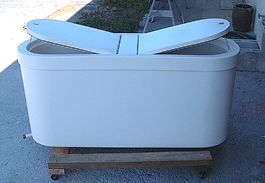

Best regards,
Capt Patrick McCrary
325.248.0809
